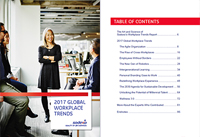Breaking the mold with design thinking
Interview with Tom Stat, Innovation Expert, Design Thinker, Strategy Consultant and Entrepreneur.
 Sodexo 2017 Global Workplace Trends Report is hot off the press with ten major trends that will impact our workplace today and in the years to come. Today we sat down with Thomas Stat, Business and Design Strategist, to learn what it means to be a design thinker.
Sodexo 2017 Global Workplace Trends Report is hot off the press with ten major trends that will impact our workplace today and in the years to come. Today we sat down with Thomas Stat, Business and Design Strategist, to learn what it means to be a design thinker.
What is your definition of design thinking?
Tom Stat: Design thinking leverages the diverse mindsets, capabilities and experiences of people in more holistic and generative ways. Design thinkers have a set of qualities about them that are relatively predictable at high levels: courage, optimism, imagination, curiosity and persistence. Mere creativity is rarely an essential force. Design thinkers have the courage to investigate, fail and learn; they think outside of the fixed box of known problems and solutions; they are excited to explore curiosity outside of their immediate domain; they are persistent. They create from a generative rather than evaluative place.
Design thinking is fundamentally about understanding outliers and their more extreme behaviors to generate insights and inspirations as opposed to focusing on the prevailing norm or the established trend. As a generative process, design thinking is about synthesizing something entirely “next” or assembling existing parts into entirely new offerings. Take for example the original iPod – it didn’t have any new technology, but rather the synthesis of existing elements into a new holistic platform of a product, a business model and a data infrastructure.
Can you speak more about how design thinking can fuel innovation?
T.S.: The history of innovation is filled with things that sounded completely ridiculous at the time – and, none of these “inventions” (innovations brought to fruition) were born out of solving an obvious or even newly established “problem.” People weren’t begging for a 24-hour news channel before CNN launched. We were perfectly happy with catalogue shopping and garage sales before Amazon and eBay. No one asked for a $5 cup of coffee to be sold in thousands of coffee shops around the world before Starbucks. Uber and AirBnB were not borne out of an obvious want or problem voiced by consumers. Ultimately, yes, these innovations met unmet needs, but they didn’t solve an obvious or widely-voiced problem. Of all the startup ideas I’m fortunate to review, if I feel they are solving an obvious problem I almost never think it’s a good idea. There has to be a bigger, more systemic and more fundamental opportunity to seize. You’re not going to create success or establish a big sustainable company out of solving a problem. History has proven that to be the case. Henry Ford famously said, “if I asked people what they wanted, they would have asked for a faster horse.” Skating to where the puck will or may be (as Wayne Gretsky once said) is part of the mindset that is fundamental to design thinking.
Does design thinking have a set process? If so, would you please explain?
T.S.: Most innovators and design thinkers follow a generative research methodology. This means that instead of conducting focus groups among hundreds of people – a traditional evaluative research method – design thinkers tend to look for insights and inspiration from very few sources – often only three or four people. The essence of generative research is not to try to determine if something is a good, bad or even valid idea, it’s about trying to have an idea. In order to do that, you tend to go to the extremes. If I’m looking for an idea for a new hotel experience, I’m not going to speak with hotel managers or people who frequent hotels; I’m more likely to get insight or inspiration if I talk to a homeless person, someone who’s never been in a hotel or a hotel doorman who’s often deeply connected to the guest experience. It’s about getting to the root and the underlying behaviors, not the surface problems or wants.
Can you provide another concrete example of generative research?
T.S.: Let’s look at leading-edge healthcare environments, like hospitals – who are always trying to innovate and define their futures for better experiences and outcomes. Emergency rooms are a classic target for innovation. To imagine the future of an emergency room, you could study and observe ERs across the country or around the world, looking for best-in-class ideas. But design thinkers often deconstruct a situation, reducing it down to its fundamental essence and imagining analogous situations where you could have entirely new insights, novel inspirations and learn something new. So in the case of ERs, the environment involves tightly orchestrated teams, a sense of urgency, time constraints, space constraints, a lot of equipment, life and death situations. So design thinkers seek a similar situation with similar characteristics that is also completely different. NASCAR pits and pit crews could be a rich source of analogous learning. Design thinkers, using a more observational and generative research process could learn more about making better ERs by studying the way that pit crews work together and manage their time and equipment. This same research approach and logic can be applied to any product, service, experience or environment – including the workplace.
How exactly does this apply to the workplace environment?
T.S.: We are intensely social beings and yet we tend to create environments that fight against this. What we need to do is design spaces to be as social, tribal and collaborative as we actually are. While in many ways business is a complete abstraction, people working together for a common purpose is deeply embedded in our behavioral DNA. Workplace environments should support our deeper nature including our ability to focus, learn, work together and alone and fail – the more adult version of play. And we need to monitor and measure workplace, team and business success in entirely new ways. That’s not to say that more traditional metrics like productivity aren’t important, but year after year when I talk to well-intended people about challenges within the workforce, they talk about people who can’t work in teams, are socially awkward, can’t communicate ideas clearly or are too risk adverse. The environment they built and ask their employees to succeed in, often supports all of the counterproductive behaviors directly related to these challenges.
I’m not saying everything has to be foosball and playground slides, but it turns out that trusting people and giving them the creative confidence to fail in order to learn is not only good, but essential. Companies that create environments that support the right behaviors and allow people to experiment, prototype, fail and iterate tend to be ahead of the curve, keep people longer, have greater success, have their brands admired and respected AND have happier, more fulfilled employees.
Can you discuss the idea of design thinking on a more global scope?
T.S.: I believe that the underlying human needs and fundamental social nature of our being is not that different from one part of the globe to another. Human beings have a wonderful habit of being human, regardless of race, religion, culture, politics, etc. That said, I have noticed that there can be cultural differences around the world that need to be respected. For example, many people in India have a whole different perspective on life. Their belief in karma and reincarnation tend to make them less dissatisfied and they tend to have a completely different model and time frame of organizational hierarchy, self improvement, life long learning and career advancement. Other cultures place different values on structure, promotions, etc. And, in every case, workplace environments tend to either support or hinder these underlying cultural values and principles.
No matter where you are in the world, it is critically important to get the most diverse input and perspective possible and to look to the extremes for insights and inspiration. And, if your goal is to imagine the next big thing, as opposed to merely incrementally improve what already exists, getting outside of your existing paradigm and traditional frame of reference is the best way to force a new experience.


